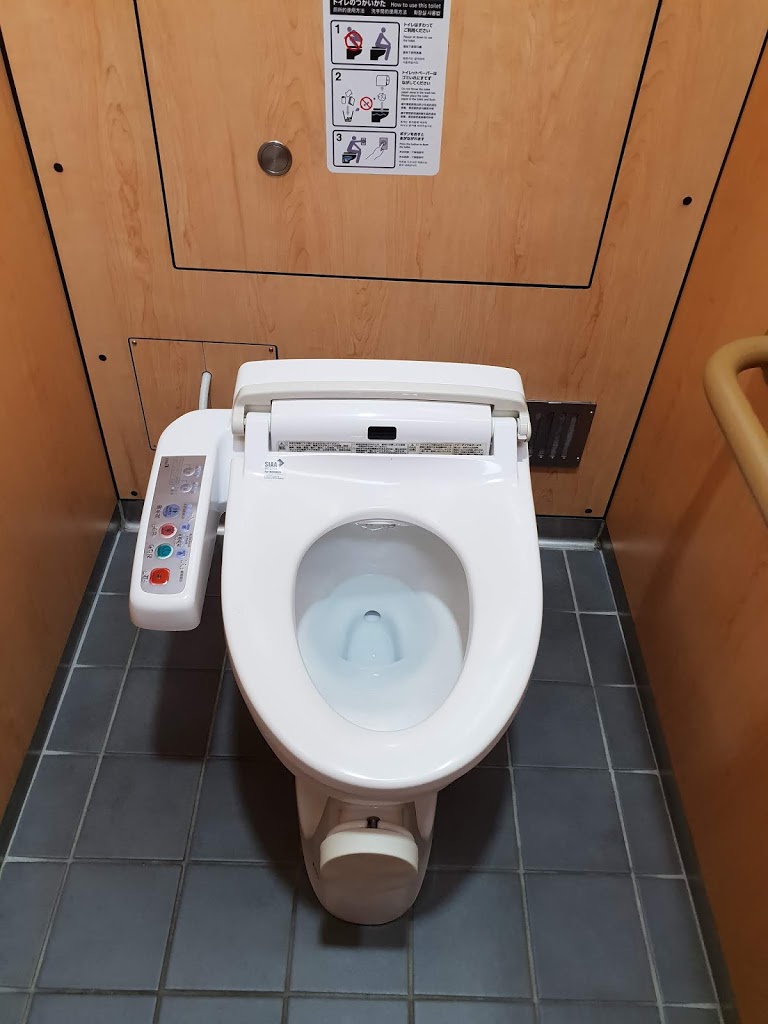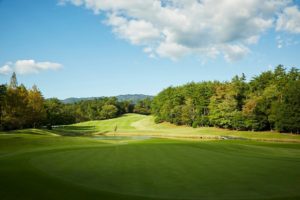In the evolving world of golf, new destinations are popping up all over the world, new countries are marketing themselves as golf friendly, whether they are or not, but one trip last year stands out in my mind above all the rest – my golf trip to Japan.
Flights are direct from the UK to Tokyo, but my final destination airport was Nagoya via Hong Kong. Arriving at Nagoya was like arriving into a shopping mall with exceptional cleanliness, shops and restaurants to divert the weary travellers eye, but my eye was firmly set on my bed for that night!
Japan is split into counties known as prefectures, Nagoya is in the Aichi prefecture and about three hours west of Tokyo, but my golf trip was to start in Mie prefecture next door. Prior to the trip, a quick internet search as to how to pronounce this came back with ‘mee’ although the locals tend to say ‘mee-ah’ either way they weren’t going to correct you with hysterical laughter at your attempt to pronounce the word; far too humble and helpful.
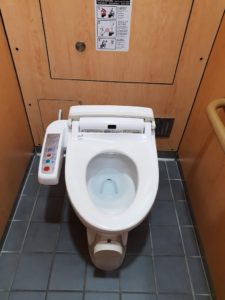
The following morning, stepping out of the international domain of the airport ‘umbrella’, Japan began to unfold, beginning with, dare I say it, the toilets. Cumbersome looking contraptions welcome your arrival, but an all singing and dancing machine of wonderment as one went about one’s business, with super cleanliness and modesty forever apparent, leaving the busy occupant impressed and startled in equal measures.
Playing golf in Japan was another experience too. Caddies take your clubs and put them on carts ready to play as you make your way to the clubhouse reception where you’ll be given a wallet. In this wallet is your locker key and a players card. Once golf ready leave everything in the lockers and just bring your wallet and players card which now acts as your personal credit facility; anything you buy from the pro-shop to the bar to the snack hut is put on credit against your name and you simply settle up one final bill before your leave at the end of the day.
I played 3 golf courses in Mie prefecture:
Nagashima Golf Club was on the cards for day one, with a steady getting you into the correct time zone, 9 holes. Nagashima built in 1991 was easy on the eye and quite playable but pretty much needed every club in my bag! Twenty seven holes of golf are available at Nagashima, each completed nine is met with a short break in the clubhouse, players card at the ready awaiting the tee time allocation for the next nine holes. Nagashima’s sculptured fairways blend seamlessly into the backdrop of the landscape with the only definition being the different colour green to guide you gently around doglegs and towards the holes. 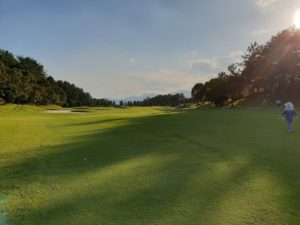 A gently undulating but quite walkable course, the four seater caddy remote controlled buggy trundled along by itself down the path as the gofers walked down the fairway with the clubs carefully organised on the back for easy access for the caddy. Water was in play for some holes creating a mirror for the rising hills in the background.
A gently undulating but quite walkable course, the four seater caddy remote controlled buggy trundled along by itself down the path as the gofers walked down the fairway with the clubs carefully organised on the back for easy access for the caddy. Water was in play for some holes creating a mirror for the rising hills in the background.

Only playing 9 holes enabled us to visit the flower gardens afterwards at Nabana no Sato. Anyone who thinks about Japan is sure to have an image of some kind of flower, usually the famed Cherry Blossom who’s season spans in excess of a month starting South and heading North as the weather improves leaving in its wake a number of festivals celebrating the trees in bloom but at that time of year the begonia was prevalent, in its mass displays creating flowered carpets tumbling down the walls in a riot of colour, who would have thought the humble begonia could be so artistic.

Sadly whilst playing Tsu (pronounced Sue) Golf Club the heavens opened, again a course of variety with it’s, in places, deep pot hole bunkers befitting a British links course! Seemingly carved out of the landscape Tsu is another relatively new course built in 1990 with the course designer being Masashi Ozaki Sato. Carved through the trees and offering challenges of long fairways and tough but reasonably large receptive greens. The weather did not detract from the game in hand and playing with three Japanese local men members gave me great insight to their style of text book golf, perfect swings and hitting

a country mile, yet soft around the greens. We were in great humour as we plodded our way around in the wet, challenging me to hit some quite difficult shots, reciprocating the challenges bestowed upon them on previous holes. Elevated greens and interesting course design left a great impression on me to return again. Food was served in the clubhouse afterwards and whilst I had been given Miso soup before, I wasn’t quite prepared for miso itself, the taste was beefy yet the texture was quite unpleasant. To my Japanese playing partners delight my face told the story! Miso is fermented soy beans and used quite a lot in Japanese cooking.
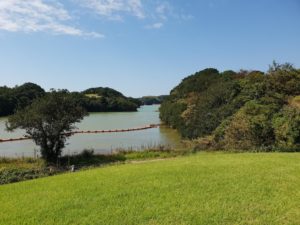

The final game of golf is Mie was at Nemu and I got to play with more Japanese men, this time from Mikimoto Pearls. Again admiring their prowess at negotiating the golf course carrying our team as I watched with a slight green tinge. Nemu golf course is a perfectly manicured golf course offering twists and turns as you finish one hole and pop out of the woods to be greeted with an inlet of sea of clear blue and a golden sandy beach edging its shores. Having vista views one can really appreciate the irregular shaped bunkers with their white sand in sharp contrast against the vibrant green fairways. A large scale course redesign in 2015 by American Damian V Pascuzzo flipped holes around to embrace the views over Ago Bay, to hit shots over the inlet and maximise the natural terrain. Positioned as a seaside course, it does not have the links feel or style as we know in the UK but does, in my opinion, sit as a combination quality cliff top and parkland course of exceptional views and playing holes.
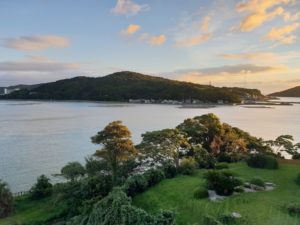
It wouldn’t be unusual to spend a full day at the golf club, play golf, eat lunch, have a few drinks then visit the Onsen.

The best Onsen’s are natural warm hot spring volcanic baths with no chemicals added. There to help erase that memory of the rubbish shot out of the bunker on the 18th! Strict rules apply when entering the Onsen. Firstly you don’t wear shoes, you leave them at the threshold or where indicated and don the ’slippers’ provided. You must wash before entering the Onsen bath, this is by way of small personal cubicle a flexible hose and a small seat to sit on. There is usually everything one might need for washing, and the final rule – you will be naked! Don’t worry, Onsen’s are split into female and male facilities. Often there will be multiple baths of different temperatures from plunge pools to larger sprawling cave like baths for peace and harmony and quite often with a view over the gardens. Afterwards, wash down again and move conveyor like onto the drying phase with big fluffy towels provided before getting dressed and leaving the Onsen feeing clean and refreshed and having forgotten the 18th hole!
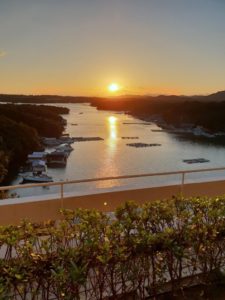
The Iga area of Mie is said to be the birthplace of the Japanese Ninja which now boasts a museum where you can learn Ninja culture and see the original weapons on display. Ago Bay in Mie is home of the 2016 G7 summit and proudly displays the round table with flags representing counties attending at the Shima Kanko Hotel.
 |
| Ama divers searching for pearls |
Mikimoto Pearl Island is also in Mie, with its founder Kokichi Mikimoto in 1893 devised a way to culture the modern day pearls we know and love today. Watching the Ama ladies dive for pearls in their traditional all white costumes covered from head to toe, and their distinctive whistle gently emitted by a small breathing tube became as characteristic as the pearls themselves. Visiting the shop afterwards gives you the opportunity to see the craftsmanship in setting the pearls in a variety of ways to display their beauty.
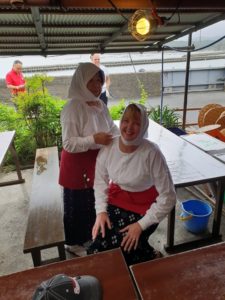 |
| One Ama too many!! |
 |
| Ama cooking fresh shell fish over an open fire |
And what better way to dine after the trip to Mikimoto Island than an Ama hut where the ladies prepare and serve the freshly caught seafood over open coals for unique tastes of the sea, dressed in their traditional attire.

Food in Japan must be one of the most colourful experiences I have ever engaged in. Carefully thought out meals are presented often on trays full of various little pots, some lidded, some not. Artisticly presented sushi might be placed in the centre of one plate taking centre stage as the colourful masterpiece deserves. Sushi with a side of proper wasabi paste (not the green coloured horseradish we are often served in the UK) is readily available in Japan. Sushi originates from South East Asia and perfected by the Japanese into the art form we recognise today.
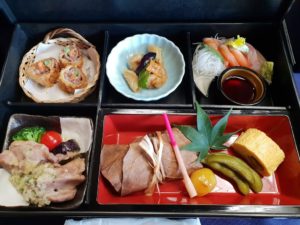
It is likely the unique tasting Miso soup is under one of the lids too, and certainly one will be rice. Kobe beef is world known as the best beef, often confused with wagyu beef. Wagyu is the collective name meaning simply ‘Japanese cattle’. In Mie the local beef delicacy is Matsusaka beef a highly sought after beef, treated the same way as Kobe but not exported to international markets. Cows are lovingly fed on beer and massaged with sake for three years to give the distinctive marbled effect and mouth watering taste.

Food in Japan is not only colourful and pleasing on the eye, it is also pleasing on the tastebuds too. Rice continues to be the main staple diet and fish is forever present on the menu, but not just fish, but quality, often raw fish. In Hyōgo, Kobe beef is served as street food, probably more expensive than the regular street food, but a great way to experience the delicate flavours of this carefully managed statement for Japanese food.
Most people think of traditional clothing in Japan as the Kimono, the word kimono means ‘garment’ and is usually associated with highly colourful, broad waist strapped garments worn by white faced ladies. The Yukata is also cotton, full length with straight seams and wide arms but are more for the everyday wear for both men and women.
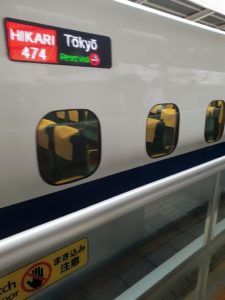
The next stop on the Japanese adventure was a trip on the Shinkansen, or bullet train. The Shinkansen was first proposed in the 1930’s and became a reality in 1964 with the first high speed train reaching up to 130mph, the bullet train name came from the shape of the trains and still resembles a bullet today. 10 million plus people ride the Shinkansen regularly and their safety record is unblemished in Japan. The more modern trains can reach up to 200 mph as a routine cruising speed. As you can image everything is timed to perfection, the train arrives when it says it would and departs fairly quickly to keep to the tough schedule. It isn’t easy to take luggage on the train, a small hand bag is fine, but the rest of the luggage is transported by road by a super efficient road network service and is ready for your arrival whilst you enjoy the train ride.
Arriving in Shizuoka, home of the notoriously shy Mount Fuji, who does show her head when she wants to reveal the beauty of the contrasting colours towering above in majestic glory. It is little known but Shizuoka boasts the best green tea production, which by arrangement you can pick and enjoy the fruits of your labour. In contrast there is also craft whisky located in the Japanese cypress built buildings for added warmth to produce locally rooted whisky in harmony with nature. Many Japanese beer’s are also brewed in Shizuoka, from blonde to heavy darker beers, there is a taste to suit all beer drinkers. The fertile soil of Shizuoka clearly is the foundation for all good things.

Golf in Shizuoka is as you can image is quite spectacular with Mount Fuji, commonly known as Fuji san (san being the honorific title for Mr, Mrs, Ms etc) ever present. Fuji Country Club celebrated it’s 60 year anniversary in 2018, proud members of Fuji Country Club show off the clubhouse and18 holes with Fuji san choosing not to make an appearance on the day of the photographs! It is shy they say with a wry smile. Hard to believe as it looms over you at 3,776 metres! Designed by Mr Shiro Akaboshi, Fuji Country Club first opened in 1958 with support
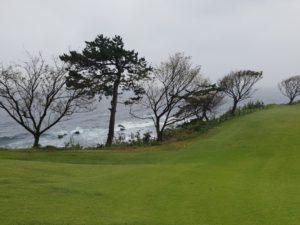
from expats and locals alike with the plan of encouraging employment in the locality and encouraging tourists into Gotemba, Shizuoka. Sadly we were unable to play the golf course but were treated to an incredible lunch! A quick scoot around the course does mean I want to go back though, as I looked longingly at the fairways drifting off into the distance to swoop around the hills never to be seen until they return, the unknown is exciting.
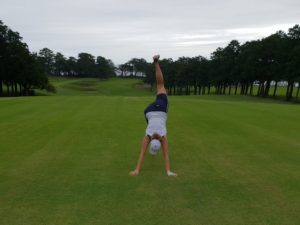 |
| Handstand for joy playing Kawana |
The Fuji Course at Kawana Golf Club is in the Top100 in the world, with a hotel on site, this little corner of Shizuoka is worth the pilgrimage to visit and stay a few nights. The Fuji course hosts an annual ladies competition every April and is often on people golfing tick list, so I was keen to take a look myself, and I wasn’t disappointed either. Firstly the hotel on site has an incredible Onsen, and whilst the restaurant for the golfer is a little lacking in character, the main restaurant is warm and welcoming, both serve great food. There are two course in Kawana; Fuji and Oshima, both are 18 holes, I only played the Fuji course.

A walking course the caddy has a push trolley which accommodates all four golf bags and she is spritely, darting here and there for the golfers, but to walk the course is a pleasure too. That said, on the odd occasion where there is a steep incline, the clever Japanese have got that covered too. There is a remote control buggy to ride to the top, a driverless buggy which picks you up and deposits you at the top before retiring back to the collect the next group. There is no controlling the speed, it was slow, but it did give you chance to breath in the fresh sea air and prepare yourself for the next vista view across the course towards the Ocean. The first hole is an elevated tee to shoot down a long fairway, a nice easy relaxing shot to prepare you for the course ahead, from there the course meanders around, up and down hills and pops you back on the top again part way round. The classic par three’s with elevated tees to target greens are more of a challenge than you’d think! Finishing hole 11 doesn’t prepare you for the 12th hole, the iconic 12th hole with the ocean on the left and the sprawling fairway ahead of you is a sight to embrace. Opening in 1936 and designed by CH Alison the fertility of the natural landscape has been maximised to please golfers and non golfers alike.
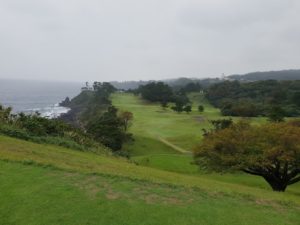
I cannot write about golf in Japan without mentioning the people themselves. The Japanese people are the most humble people I have met, they are willing to please, but not just please but will go the extra mile to make your trip the best it can be. Their knowledge of the English language isn’t great, but as the language of golf is international, any other obstacles can be overcome with translating apps. Caddies generally don’t get a tip, nor do they expect one, but sometimes a small monetary reward is given because they have done a good job.
Facts
*Japan will be hosting the Rugby Word Cup across numerous prefectures this year
*The Akashi-Kaikyo Bridge is the longest suspension bridge in the world at 3911 metres, and connects some of the islands to the mainland
*Face masks are worn not to keep pollutants out, but because the wearer has a cold and wants to be considerate for others.
*Japan has in excess of 2,300 golf courses
*The climate in Japan is seasonal. However the central and northerly prefectures can experience snowfall whilst the the southern ones are basked in sunshine.
*It is Ok to sleep at work! 10 to 20 minute power naps are not discouraged
*Japan is made up of 6,852 islands
*The Japanese name for Japan is Nippon
*With Shinto and Buddhist cultures, there are many shrines to visit for a true authentic feel for the history of Japan
This article was first published in Upswing, The Wisley Golf Club magazine. Credit to Ad Store UK for publishing and design
 The following morning, stepping out of the international domain of the airport ‘umbrella’, Japan began to unfold, beginning with, dare I say it, the toilets. Cumbersome looking contraptions welcome your arrival, but an all singing and dancing machine of wonderment as one went about one’s business, with super cleanliness and modesty forever apparent, leaving the busy occupant impressed and startled in equal measures.
The following morning, stepping out of the international domain of the airport ‘umbrella’, Japan began to unfold, beginning with, dare I say it, the toilets. Cumbersome looking contraptions welcome your arrival, but an all singing and dancing machine of wonderment as one went about one’s business, with super cleanliness and modesty forever apparent, leaving the busy occupant impressed and startled in equal measures. A gently undulating but quite walkable course, the four seater caddy remote controlled buggy trundled along by itself down the path as the gofers walked down the fairway with the clubs carefully organised on the back for easy access for the caddy. Water was in play for some holes creating a mirror for the rising hills in the background.
A gently undulating but quite walkable course, the four seater caddy remote controlled buggy trundled along by itself down the path as the gofers walked down the fairway with the clubs carefully organised on the back for easy access for the caddy. Water was in play for some holes creating a mirror for the rising hills in the background.
 The final game of golf is Mie was at Nemu and I got to play with more Japanese men, this time from Mikimoto Pearls. Again admiring their prowess at negotiating the golf course carrying our team as I watched with a slight green tinge. Nemu golf course is a perfectly manicured golf course offering twists and turns as you finish one hole and pop out of the woods to be greeted with an inlet of sea of clear blue and a golden sandy beach edging its shores. Having vista views one can really appreciate the irregular shaped bunkers with their white sand in sharp contrast against the vibrant green fairways. A large scale course redesign in 2015 by American Damian V Pascuzzo flipped holes around to embrace the views over Ago Bay, to hit shots over the inlet and maximise the natural terrain. Positioned as a seaside course, it does not have the links feel or style as we know in the UK but does, in my opinion, sit as a combination quality cliff top and parkland course of exceptional views and playing holes.
The final game of golf is Mie was at Nemu and I got to play with more Japanese men, this time from Mikimoto Pearls. Again admiring their prowess at negotiating the golf course carrying our team as I watched with a slight green tinge. Nemu golf course is a perfectly manicured golf course offering twists and turns as you finish one hole and pop out of the woods to be greeted with an inlet of sea of clear blue and a golden sandy beach edging its shores. Having vista views one can really appreciate the irregular shaped bunkers with their white sand in sharp contrast against the vibrant green fairways. A large scale course redesign in 2015 by American Damian V Pascuzzo flipped holes around to embrace the views over Ago Bay, to hit shots over the inlet and maximise the natural terrain. Positioned as a seaside course, it does not have the links feel or style as we know in the UK but does, in my opinion, sit as a combination quality cliff top and parkland course of exceptional views and playing holes. The best Onsen’s are natural warm hot spring volcanic baths with no chemicals added. There to help erase that memory of the rubbish shot out of the bunker on the 18th! Strict rules apply when entering the Onsen. Firstly you don’t wear shoes, you leave them at the threshold or where indicated and don the ’slippers’ provided. You must wash before entering the Onsen bath, this is by way of small personal cubicle a flexible hose and a small seat to sit on. There is usually everything one might need for washing, and the final rule – you will be naked! Don’t worry, Onsen’s are split into female and male facilities. Often there will be multiple baths of different temperatures from plunge pools to larger sprawling cave like baths for peace and harmony and quite often with a view over the gardens. Afterwards, wash down again and move conveyor like onto the drying phase with big fluffy towels provided before getting dressed and leaving the Onsen feeing clean and refreshed and having forgotten the 18th hole!
The best Onsen’s are natural warm hot spring volcanic baths with no chemicals added. There to help erase that memory of the rubbish shot out of the bunker on the 18th! Strict rules apply when entering the Onsen. Firstly you don’t wear shoes, you leave them at the threshold or where indicated and don the ’slippers’ provided. You must wash before entering the Onsen bath, this is by way of small personal cubicle a flexible hose and a small seat to sit on. There is usually everything one might need for washing, and the final rule – you will be naked! Don’t worry, Onsen’s are split into female and male facilities. Often there will be multiple baths of different temperatures from plunge pools to larger sprawling cave like baths for peace and harmony and quite often with a view over the gardens. Afterwards, wash down again and move conveyor like onto the drying phase with big fluffy towels provided before getting dressed and leaving the Onsen feeing clean and refreshed and having forgotten the 18th hole!


 It is likely the unique tasting Miso soup is under one of the lids too, and certainly one will be rice. Kobe beef is world known as the best beef, often confused with wagyu beef. Wagyu is the collective name meaning simply ‘Japanese cattle’. In Mie the local beef delicacy is Matsusaka beef a highly sought after beef, treated the same way as Kobe but not exported to international markets. Cows are lovingly fed on beer and massaged with sake for three years to give the distinctive marbled effect and mouth watering taste.
It is likely the unique tasting Miso soup is under one of the lids too, and certainly one will be rice. Kobe beef is world known as the best beef, often confused with wagyu beef. Wagyu is the collective name meaning simply ‘Japanese cattle’. In Mie the local beef delicacy is Matsusaka beef a highly sought after beef, treated the same way as Kobe but not exported to international markets. Cows are lovingly fed on beer and massaged with sake for three years to give the distinctive marbled effect and mouth watering taste. Food in Japan is not only colourful and pleasing on the eye, it is also pleasing on the tastebuds too. Rice continues to be the main staple diet and fish is forever present on the menu, but not just fish, but quality, often raw fish. In Hyōgo, Kobe beef is served as street food, probably more expensive than the regular street food, but a great way to experience the delicate flavours of this carefully managed statement for Japanese food.
Food in Japan is not only colourful and pleasing on the eye, it is also pleasing on the tastebuds too. Rice continues to be the main staple diet and fish is forever present on the menu, but not just fish, but quality, often raw fish. In Hyōgo, Kobe beef is served as street food, probably more expensive than the regular street food, but a great way to experience the delicate flavours of this carefully managed statement for Japanese food. The next stop on the Japanese adventure was a trip on the Shinkansen, or bullet train. The Shinkansen was first proposed in the 1930’s and became a reality in 1964 with the first high speed train reaching up to 130mph, the bullet train name came from the shape of the trains and still resembles a bullet today. 10 million plus people ride the Shinkansen regularly and their safety record is unblemished in Japan. The more modern trains can reach up to 200 mph as a routine cruising speed. As you can image everything is timed to perfection, the train arrives when it says it would and departs fairly quickly to keep to the tough schedule. It isn’t easy to take luggage on the train, a small hand bag is fine, but the rest of the luggage is transported by road by a super efficient road network service and is ready for your arrival whilst you enjoy the train ride.
The next stop on the Japanese adventure was a trip on the Shinkansen, or bullet train. The Shinkansen was first proposed in the 1930’s and became a reality in 1964 with the first high speed train reaching up to 130mph, the bullet train name came from the shape of the trains and still resembles a bullet today. 10 million plus people ride the Shinkansen regularly and their safety record is unblemished in Japan. The more modern trains can reach up to 200 mph as a routine cruising speed. As you can image everything is timed to perfection, the train arrives when it says it would and departs fairly quickly to keep to the tough schedule. It isn’t easy to take luggage on the train, a small hand bag is fine, but the rest of the luggage is transported by road by a super efficient road network service and is ready for your arrival whilst you enjoy the train ride. Golf in Shizuoka is as you can image is quite spectacular with Mount Fuji, commonly known as Fuji san (san being the honorific title for Mr, Mrs, Ms etc) ever present. Fuji Country Club celebrated it’s 60 year anniversary in 2018, proud members of Fuji Country Club show off the clubhouse and18 holes with Fuji san choosing not to make an appearance on the day of the photographs! It is shy they say with a wry smile. Hard to believe as it looms over you at 3,776 metres! Designed by Mr Shiro Akaboshi, Fuji Country Club first opened in 1958 with support
Golf in Shizuoka is as you can image is quite spectacular with Mount Fuji, commonly known as Fuji san (san being the honorific title for Mr, Mrs, Ms etc) ever present. Fuji Country Club celebrated it’s 60 year anniversary in 2018, proud members of Fuji Country Club show off the clubhouse and18 holes with Fuji san choosing not to make an appearance on the day of the photographs! It is shy they say with a wry smile. Hard to believe as it looms over you at 3,776 metres! Designed by Mr Shiro Akaboshi, Fuji Country Club first opened in 1958 with support  from expats and locals alike with the plan of encouraging employment in the locality and encouraging tourists into Gotemba, Shizuoka. Sadly we were unable to play the golf course but were treated to an incredible lunch! A quick scoot around the course does mean I want to go back though, as I looked longingly at the fairways drifting off into the distance to swoop around the hills never to be seen until they return, the unknown is exciting.
from expats and locals alike with the plan of encouraging employment in the locality and encouraging tourists into Gotemba, Shizuoka. Sadly we were unable to play the golf course but were treated to an incredible lunch! A quick scoot around the course does mean I want to go back though, as I looked longingly at the fairways drifting off into the distance to swoop around the hills never to be seen until they return, the unknown is exciting.

